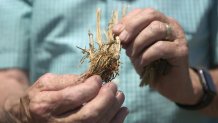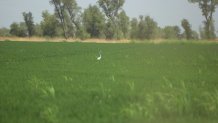A loping breeze tugged and pulled at the straw colored weeds, the only things in motion in Donald Bransford's drought-stricken fields in Colusa County, which this time of year would normally be carpeted with a verdant green blanket of rice shoots.
"I’ve been farming since 1980," Bransford said surveying the dirt plain. "I’ve had a rice crop every year except for this year."
Bransford and other rice farmers working the rice belt on the west side of the Sacramento Valley have survived other years of drought, continuing to farm even when state and federal regulators reduced water deliveries for lack of rain. But this year, the drought has plowed into new territory.
In a normal year, Bransford would receive 100% of his water allotment. In a bad rain year, he would get 75%. But this year, as California chokes from a crippling, drought of historic proportions, Bransford only got 14% of his water. Not enough to justify sowing the ground or toiling over a rice stalk with virtually no chance of survival.
Get a weekly recap of the latest San Francisco Bay Area housing news. Sign up for NBC Bay Area’s Housing Deconstructed newsletter.
"We are in new history," Bransford said. "We are in unprecedented drought, we’re in a time where there are lake levels they’ve never experienced."
The majority of the region's 250,000 acres of rice fields are fallow this year. A study by the University of California, Davis set the toll for the region's 2022 lost rice harvest at $1.3 billion in losses, with more than 14,300 jobs gone.
"The fact that I’m not farming this year," Bransford said, "has a huge impacts to a lot of businesses and a lot of people."

This year, the area's ubiquitous rice silos lining the highways only hold the remains of last year's crop, with no prospect for a current crop to take their place. The region's rice mills sit mostly silent.
Local
Around the Colusa County town of Williams where Bransford farms, only about 1,000 of the normal 100,000 acres were planted with a rice crop this year. The few farmers able to plant on their land are those with access to groundwater, which is extremely rare in the county.
Bransford guided his truck past field after field of dirt clods and parched irrigation ditches until he came to what seemed like a mirage; a neighbor's groundwater-fed rice fields -- a lush green oasis of rice stalks basking in standing water.
It's what Branford's fields would look like in a normal year with irrigation pumps providing the pivotal soaking. Instead, it is an anomaly as Bransford put the scene in perspective.
"This is a few hundred acres," he said, "and there’s over 200 to 250,000 acres that are fallowed because of this drought."
The sight of acres of lively plantings bathing in the valley sun illustrated a collateral benefit of the rice fields -- in addition to food crops, they're home to thousands of shore birds making the trek along the Pacific Flyway.

In this pastoral setting, Egrets -- their bleach white bodies cast against the green stalks -- stood statue-like waiting for prey. Long-legged ibises waded through the ripples of water on the hunt. A mallard duck called out from somewhere within the stalks.
"Two-hundred and thirty species of wildlife inhabit these fields as these crops grow," Bransford said. "They live in harmony with these rice fields."
With 95% of California's wetlands gone, Michael Lynes, director of public policy for Audubon California, said the rice fields are a vital resource for shore birds. And with the drought claiming most of this year's fields and their offerings of food and water, he fears the future impact on bird populations.
"So as we sort of choke the remaining habitat that’s left," Lynes said, "as we dry it up and give birds less we will continue to see those declines and for some populations those declines will happen even more quickly."
Bransford has heard the rumblings over the years, those who've blasted the foolishness of growing a water-dependent crop in an area whose fortunes rise and fall with the rains.
Bransford points to the birds as just one justification for their existence. But another is every farmer's pride of putting food on the table -- which in Colusa County turns out most of the nation's high-quality sushi rice.
"We grow cheap, affordable food and that’s very important, Bransford said. "And with inflation today that’s all the more important."
But Bransford acknowledged the future of his industry is in the hands of mother nature, and the deepening impact of climate change which has unleashed unusual winds while choking off rain.
In his fields these days, the only work underway was a tractor plowing under the weeds which are the only living things that seem to thrive without rain here.
"We never planned for a year like this," Bransford said, driving his truck along his mournful lands, " and not much we can do, but wait for a better time."



